jmac's sf27 report

In February 2002 I attended sf27, the twenty-seventh instantiation of an annual 24-hour scifi movie marathon held at the Coolidge Corner movie house in Brookline. With me were excellent friends Noah and Melissa, who had both done this before (Noah went last year, and this was Melissa's fifth time). I found it as much of a life-changing experience as one can reasonably expect to have from this sort of thing, and what follows is a summary of my experiences there.
Standing in Line
Melissa and Noah will tell you that they did not have fun standing in line last year. It was bone-chillingly cold and raining, and they found themselves taking lonely turns holding their spot while the other took a warm-up break in the nearby McDonald's with its hot chocolate. Thus, they made sure I showed up in warm clothes and bore an umbrella. Fortunately, it wasn't very cold, and though rain started to threaten with a teasing drizzle as soon as we arrived at the Corner via the T, it never got any worse than that.
The wait itself, while feature-length in its own right, somehow managed to not be boring. J&M&N are a pretty electric bunch when we're together and in a good mood, so we ended up gabbling happily the whole time. Melissa invented a dance called "the jmac", which is performed to the tune of "the hustle". She also suggested commemorating our sf27 experiences with a song. Did this inspire me to take notes? Perhaps.
We also passed the time talking to the guy ahead of us about "Voyager", and watching someone with a radio-controlled Tom Servo. We brought along an Icehouse set with the thought that we'd get some Zendo in, but never really got into the right mood for it. The total wait might have been around 90 minutes.
Trends and traditions
Melissa briefed me on marathon ettiquite while we stood in line. Everything she mentioned would, indeed, come to pass:
- During slow moments, people may instigate the crowd into a Wheat Chex vs. Corn Chex shouting match. People who wish to participate pick one side or the other, and take turns yelling the name of their favored cereal at the other side. I don't know if people tend to choose the same cereal every time or not. (It was a spontaneous manifestation of this phenomenon whhile we stood in line that prompted Melissa to fill me in on this list. It would happen a few more times inside the theatre.)
- The opening credits to every film are met with a single, coordinated clap for each name that appears, as it appears. So a slow credit scroll gets slow, rhythmic clapping. A screen of one credit that dissolves into three more gets one, and then three claps. You're supposed to only clap for individuals' names, though. You may mock people who accidentally clap for companies' names, or random words. (Terminal Man fooled almost everyone when it flashed the word 'monday' in the same typeface as the opening credit. These people then tried to pretend they meant to do it by clapping for all the film's subsequent chapter-heading titles. All was well.)
- The marathon is almost always led by a showing of "Duck Dodgers in the 24th 1/2 Century", and everyone gets handed an Atomic Fireball candy on their way into the theatre. When the big WB logo appears, everyone pops their respective candies into their mouths at the same time. (I think it was the first time I had ever seen a WB cartoon on the big screen, let alone with a theatreful of people who knew half the lines by heart. I felt a twinge of cosmic irony when Chuck Jones died just a few days later.)
(Only after writing the above did I discover a page explaining the origins of these traditions.)
However, as it's now going on three decades, the marathon is home to a much subtler catalog of inside jokes that have calciated with each new layer of shlock applied to this audience, year after year. I'm sure many went by that I never caught, patterns that I won't pick up on until I've attended for a few years in a row, myself.
One of these I learned about by happenstance. My leftward seatmate was a stranger, a middle-aged man whose shtick involved some homemade-looking optic contrivance that caused the word "MARK" to appear on the screen in glowing red letters, cueing people around the crowd to shout "Mark!" Assuming that he was Mark, I asked him about this at one point between shows: did he do this gag every year? No, he said, this was the first time he brought this toy, but the "Mark" thing is a running joke dating back to sf1. (Apparently a particular film featured people yelling that word as a substantial portion of its total dialogue. This background image from the sf27 website references it, too.) Unfortunately, he responded to my next obvious question by saying that he'd been attending only since sf2, so I can't brag about chatting with any true twenty-seven-timers, but this was still pretty nice.
He had better comic timing than a person elsewhere in our row who thought it clever to randomly wiggle a laser pointer's dot around on the screen, but the crowd booed him into better behavior after about three films. Somwhere in between was the person who shined a flashlight around to coincide with an on-screen character's action; this gag appeared once, and was well-received.
At the end of "The Terminal Man", the last movie (not counting the off-topic bonus flick "The Indepedent"), "Mark" or someone like him shined the word "PITA" on the screen alongside the final image of a helicopter flying away, thus closing the sf27 curtain with a battery of Neanderthal howling.
Talkback
It is not necessarily considered impolite to talk back to the movies at the sf marathon. As the hours wear on and the crowd gets punchier, talkback increases, with bonus points for shouting out references to films already shown when appropriate, such as the guy who got laughs for repearing Professor Xavier's chess-playing line from "X-Men" during a chess-playing scene in "The Omega Man".
Some attendees needed to adapt to this mindset; I received a few shushings during the first couple of movies after "X-Men" (which, being a new and cool movie, most everyone was silent for). These people seemed to give up at around "These are the Damned" or so, finally realizing, through observation, that standard movie-watching ettiquite didn't apply here.
The Movies
These reactions appear in the same order as sf27's film schedule.
X-Men
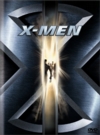
Sf27's organizers decided to start the evening off on guaranteed positive footing with this one, not yet two years old and still kicking square miles of ass. As someone nearby remarked when it was done, you'd be hard-pressed to deny this was one of the finest comic book-to-film adaptations ever.
This movie and Happy Accidents were perhaps the only two of the marathon where the audience let itself get swept along for the ride exactly as the filmmakers intended, reacting to everything as a typical movie audience might, expect maybe just a little more boisterous. And that was all right. I ended up feeling happy that I had never gotten around to seeing it before the marathon.
This was also the first movie I've seen post-9/11 that prominently featured the Twin Towers in several shots. Hum.
One of the closing music credits belonged to the title Fox News Update.
Iceman
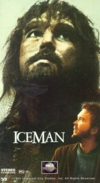
This was the only film that I had seen before, though it was more than 15 years ago on HBO. In fact, the only things in particular I remember about it are the bits involving one minor character, whom the unfrozen caveman non-lawyer runs through with his spear, but much more interestingly is seen playing the same ancient hand-held circa 1982 LCD Donkey Kong Nintendo "Game & Watch" game. You remember, the really cool-looking one, that had two separate screens.
You know exactly what kind of movie crowd you're among when a brief close-up shot of a Donkey Kong game results in an eruption of cheers. Much like Terminal Man, the film seemed to play to its audience a little later, when it segued to a barroom scene by flashing full-screen shots of about a half-dozen period arcade games, each collecting its share of enthustiastic response from the crowd. Geeks!
Beyond this silly stuff, I found the movie is actually honestly enjoyable for its own sake. It told an honest story, which was pretty cool, even if it did so through through a layer or three of unbelievable nonsense -- the sf27 environment made this a positive thing.
Honestly cool: the scenes of the gentle and heroic scientist bonding with the caveman. We found the long scene where they (sort of) sing a Neil Young duet was funny in exactly the way the creators intended.
Unbelievable nonsense: Where did this arctic research station get the resources to set up an enclosed caveman habitat because of one scientist's whim (which all the other scientists seem to disagree with)? We're given no cue as to how much time or money they spent on this, and why the global media never show an interest in it. But, it's not important: the movie really wants to get to the caveman-clashing-with-modern-people stuff. That's its right.
Unfortunately, Things Go Terribly Wrong as a result of nearly all the characters doing Really Dumb Things. The story's main tragedy is set up when one of the research base's helicopters hovers over the caveman's bio-dome thingy for a while. Why does it do that? Cuz the pilot was stupid, I guess. Later in the film, the caveman breaks out, and the same helicopter appears, and accidentally bonks him unconscious with one of its feet. Huh? It would have been one thing if it was revealed: aha, the pilot is the bitter enemy of the hero scientist who wants the project to fail, and uses his helicoptering skills to sabotage it any way he can, but no. The base apparently just has one or more really dumb pilots, who we never meet. Fooey.
Not that the main characters seem all that bright, either. The caveman breaks out after straining his Neanderthal brain to puzzle out the lock mechanism on the door that separates his habitat from the rest of the station. It consists of a giant green button behind an unlocked access panel. On the caveman's side. When this showed up, the whole audience groaned, and Noah turned to quip at me: "Gee, jmac, you have better security than that on your server." Nrr. Anyway, he's able to press the button without anyone seeing him when all the people assigned to observe him all get up at once to go look at something else. The next scenes with the caveman running around the station's empty hallways in a panic, scared shitless by all the stuff utterly beyond his comprehension, are actually pretty neat, but not enough to prevent people from asking the movie where the heck all the researchers disappeared to. (The movie didn't know, either.)
If there's one lasting impression this film made on the audience, though, it's the word "pita", spoken in the same scratchy howl as the title character, for this was the name of his god, and something he starts yelling a lot as soon as he sees that annoying helicopter. (Actually, I think it was something more like "bida", but it's funnier to think that his tribe worshipped Middle Eastern bread products, I suppose, so that's the interpretation the audience chose.) For the rest of the marathon, people (including myself) would cry it aloud whenever any movie depicted someone clinging to a cliff face, or a helicopter -- which happened a lot. If you make a rule to scream arbitrarily whenever helicopters appear in a movie, you may discover that helicopters show up in movies more often than you may expect. I bet this works with all kinds of objects. So there you go.
I'll be most curious to see if this particular running gag survives to qualify as a full-fledged inside joke by enjoying audience invocation during sf28, next year.
The Omega Man

So yes, this is the official film of the NRA. The opening shot features Charleton Heston driving leisurely in his convertible down the wrong side of an L.A. avenue, then stopping suddenly, leaping from the car, and shooting up a building at random with an automatic weapon, causing the film's titles to appear. Yeehaw!
As far as he knows, Chuck is the last man alive, and must defend his heavily armed home from radioactive albino zombies who are trying to take his guns away. Naturally he meets an enclave of other humans shortly after we meet him, and flashbacks inform us that he's immune to the bacteria that encouraged the rest of his fellow Angelinos to dress in shiny black cloaks and wear expensive sunglasses while they chase him with torches until he finishes shooting them all.
The ending is the best part, though: after the head zombie thing sticks him in the side with a spear, he collapses with splayed arms and bent knees into a fountain, and his grieving followers collect his final gift, a vial of his serum-enriched blood, as the camera lingers on this image, the Passion of Chuck. A cry of "Chuck died for your sins!" echoed through the theater.
This film shares a quality with many (most? all?) action films before a certain point in the 70s (pre-"Star Wars"?) of having a musical score that seems rather inappropriate through most of the action. Lots of unusually relaxed pieces emphasizing either strings or trumpets. I found myself singing along to what sounded awfully close to an electric piano rendition of "Scarborough Fair" during one scene of Chuck & co. running over mutants with motorcycles. Maybe it was technologically harder to score films inexpensively back then? Shrug.
The Lost World
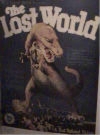
This was the original 1925 silent movie version of Sir Arthur Conan Doyle's novel, in the form of a restored print made from splicing together reelbits from many sources, the long list of which was thanked in a special additional opening credit screen.
The film itself was an outrageous cartoon of a story, directly comprable to any number of Popeye cartoons from the same period. Film was still too young for any amount of subtlety with the artform to find its way into mainstream application, I suppose. Anyway, it was something about a nosey reporter who had a penchant for breaking into mad scientists' homes and seducing their daughters before going on quests where he and his friends and also a cute little monkey get to gape at stop-motion dinosaurs. But, dude, movie dinosaurs from 1925! What else do you want?
Like so many pieces of popular media from that time period, the film contains a goofy, childlike African-American character, portrayed by a white guy in blackface whose dialogue cards all contain hyper-ebonic dialect, sending squirms through the audience whenever one appeared. After a couple of these, many people (including myself) found it acceptable to vent our discomfort by hissing at them. (This character was actually half of the comic relief team; his partner was a British character whose dialogue was all spelled in hyper-Cockney. This didn't help.)
On the other hand, the film brought about the marathon's one standing ovation, by way of Yakov, an Isreali professor of film and music visiting Harvard. He played nonstop improvised piano music (on an electronic keyboard)
Happy Accidents

I remembered this one from trailers I had scene and review snippets I had read last year, and thought it was a run-of-the-mill contemporary romantic comedy with a sprinkling of science fiction over it. I mean, it had Marisa Tomei in it. It also had a goofy-but-charming guy trying to be her special friend with the twist that he insisted he was a time traveler from the distant future. Would they be able to work out their wacky, koo-koo differences? I thought: blarf, and convinced my friends that this would be a good time to go next door to Vici's for salad and pizza.
While this ended up being a good idea (we were all kind of crabby from a day of voluntary malnutrition, and the healthy food had an immediate effect on us), I still felt a little bad about missing the beginning of the film (we walked in just as the goofy guy was successfully seducing MT's character, maybe 25 minutes into the story). It turned out that the ever-cynical audience was loving this movie, and we quickly joined them in it. Yes, it was a romantic comedy, but the theme of time travel and its inherent problems was intertwined throughout, not just there for color, and the result was surprisingly interesting. Beyond that, the film itself was really well-made, with a lot of smooth and pleasing visual sequences.
This movie captured the best moment of honest, non-ironic joy from the crowd, which erupted with cheers at a point that was, in fact, meant to be beautiful. I shan't spoil it, but I'll say that it was in reaction to the bit where the goofy guy answers a question using a wineglass.
These are The Damned
a.k.a. The Damned

A creepy, lecherous, middle-aged American man on holiday in England stumbles across a secret government plot to raise a generation of radioactive children. It takes him about half the film's length to synch up with that thread, though; the rest of the time he's being creepy and lecherous with a clingy British waif, and getting into trouble with her conflicted biker brother and his gang of droogs. There's also some business involving a scultpor who has a problem with every other character in the movie entering her home to engage in drama. Actually, she has very little problem with it, leading to confusion as to whether these characters are supposed to know each other or not. Is she being polite to her intruders, or sarcastic to her friends? I think she is just being very British.
Many films involved a theme of men (often very creepy but heroic men) meeting, seducing, and then announcing their engagement to women (often much younger women) within a ten-minute span of real time. Say what you will about the other elements, but love interests, whether sudden or gradual, rarely if ever pop the question in film anymore; it's usually enough nowadays to know that the story ends with them as lovers. (Actually, in these and other older movies I have seen, there is in fact no question popped, with the man instead proposing indirectly by asking permission of the woman's father, or just telling some random third person of his wedding plans, at which the woman reacts with surpised delight. This is all very strange.)
Even if the story was muddled, the cinematography was honestly delicious, full of all kinds of beautiful and sometimes even subtle shots. (Watch the monitors in the control room as the children revolt; though characters in the foreground are speaking, each still shows a child disabling that monitor's camera in some way, simultaneously.) It seemed almost too rich for the material, but ultimately made the movie quite watchable.
The film also contained perhaps the single funniest moments of spontaneous audience-participation: when one character told others that they must remain quiet while in a certain room, every line for the remainder of the scene received a full-house shushing.
The movie's theme was a pean to thrill-kill beatniks and the clothing they wore called "Black Leather". (Unfortunately I can't find the lyrics on the Web. They went something like "Black leather, crash crash crash! Black leather, kill kill kill!" and were sung by a Sinatra-oid.) It provided another fine running gag that lived through the marathon's remainder. You could tell that a character was bad, or at least conflicted, if they sang this song. The naughty bikers whistled it to one another as a signal. Naturally, in all subsequent movies, the audience whistled it whenever it seemed appropriate. In particular, the evil nurse in "The Terminal Man" got it every time he showed up.
Most memorable line:
Strange English Girl: You haven't even asked me my name.
Creepy American Man: With a figure like that, you don't need a name.
We found this adaptable as screen talkback to a great many other lines in this and future films where any character mentioned his or her lack of anything. ("With a figure like that, you don't need an oxygen destroyer.")
Wave Twisters
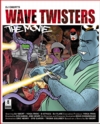
Poor "Wave Twisters"; it didn't deserve the reception it got at sf27. A 45-minute long hip-hop music video, it definitely would make excellent eye candy (and, optionally, ear candy) to run in a televised loop in the background of a social gathering in one's home, along the same lines as Looney Labs' "Aquarius Girls" videos. Unfortunately, showing it to a theaterful of sci-fi geeks who have nothing else to do but sit and watch it just doesn't work, despite the fact that it's crammed full of geeky references to Atari games (the movie even starred one DJ Qbert), StarCraft, and Macintosh (though I suspect the latter of these caused even more hositily in some audience members, though I was howling at the Norton Disk Doctor sequence).
The thing that killed it was its length; the character design, animation, and whacked-out story would have set the wholecrowd in stitches had it been one-fifth as long. Unfortunately, according to the film's website, it really was meant to be the video for an album-length audio composition of the same title, and so no abbreviation was allowed. The animation tried to stay as manic as it reasonably could, switching scenes whenever the music switched measures, but, being hip-hop, this can take a long time, with each musical sentence using repetition and syncopation to unhurriedly meander its way to completion.
I might note that screaming "No! Make it stop!" and the like at a film when others are clearly enjoying it isn't really cool.
Godzilla versus Destroyer
a.k.a. Gojira vs. Desutoroia

(This one seemed to contain a disproprotionate amount of audience talkbalk, so I'll summarize all of it in square brackets.)
I believe this was the film that made international headline as the one where Godzilla Actually Dies. He doesn't get beaten up until he sinks into the sea, like usual; he melts into a puddle of Gojira Sauce, Wicked Witch of the West-style [I'm mellll-tiiiing!]. Throw in the fact that Zilla Jr. also eats it and the hero is the nerdy teenage grandson of the eyepatch-wearing [Arrrr, matey!] hero from the very first Godzilla film (about ten minutes of which show up as black-and-white flashbacks), and you have some pretty obvious attempts at tying up the whole Godzilla storyline.
The plot concerns Godzilla being upset by the fact that he has turned Day-Glo orange. This makes him stomp Tokyo several times. (The movie seems to contain two Tokyos: The citizens of one react to Godzilla in the usual point-and-flee way, and the buildings are but crumbly cardboard under the monster's furious beatings. But sometimes we see shots of Big G wandering through the background of a different Tokyo, where pedestrians don't spare him a glance as they go about their day and traffic flows by normally. Godzilla does not attack the buildings of this Tokyo. There may be a message here.)
The United Nations Godzilla Control Center hastily convenes a Godzilla Summit [!!!] that determines that Godzilla has a problem with his heart [Awww...]: it works like a nuclear reactor (or, as the nerdy teenage grandson liked to call it, a "nucular" [AAARGH!] reactor) and it had outlived its fuel supply or coolant or something, bringing poor Godzilla to the brink of meltdown. This would cause him to either explode and ignite the Earth's atmosphere [!!!], or sink into the Earth's core and cause other undesirable effects.
Nerdy teenage grandson thinks that the only way to safely put the smackdown on the radioactive lizard involves rebuilding his grandfather's "oxygen destroyer", but the irritated scientist guy working on, um, oxygen-destruction experiments does not wish to do this: it's too dangerous! Then some microbes escape from one of his destroyed-oxygen soil samples [?!?!] and invade a warehouse shaped like a Giant H where they become big and bulletproof and they eat a bunch of soldiers. The grandson blesses the luck: they now merely need to get these new oxygen-destroyer monsters to fight Godzilla!
At some point somebody invents special low-temperature lasers that cause giant lizards to get all icy, and also manage to convert the same technology into rockets and artillery. These get packed onto a new high-tech super-fighter jet with its own Maricachi-style theme music, as well as a lot of tanks, which kill most of the giant oxygen destroyers, but encourage the survivors to combine into one big Destroyer, so they all run away.The big battle has two women with ESP links to Baby Godzilla [?!?!] luring it as bait to attract Big Godzilla into the Tokyo industrial district, which proceeds to get leveled as the Destroyer kills Baby and then fights for at least 25 explosion-filled minutes with its angry daddy. Godzilla finishes it off just as his temperature hits the cutoff point of 1,200 degress Celsius and he starts to blow up, but the Maricachi jet freezes him, so he just melts harmlessly instead. Everyone is very sad. The end.
Doctor X
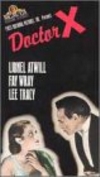
A 1930s murder mystery where mad scientists accuse each other of being the serial killer terrorizing the city. The best line might have been one scientist bosting about a beating heart he keeps jarred on his desk: "I've kept it alive for over three years through electrolosys!"
I'd recommend this film to anyone just for all the mad-science tropes it manages to pack into a single film. The central characters are a bunch of mad professors at a mad-science university that conveniently abuts a morgue (which bears the sign "RIVER ST. MORGUE", causing Melissa to declare herself St. Morgue). Vials of bubbling liquid are everywhere, as are jacob's ladders, all presented without a trace of irony. Beautiful.
The hero is a nosey reporter who likes playing pranks with his joy buzzer (which you know that he'll eventually use to defeat the monster in the end) and has a penchant for breaking into mad scientists' homes and seducing their confused daughters. There is a long and painful scene where he is stuck in a prop closet and keeps backing into skeletons, at which he makes why-I-oughtta faces. Finally someone sleep-gases him so that we can get back to the mad science.
The Creature With the Atom Brain
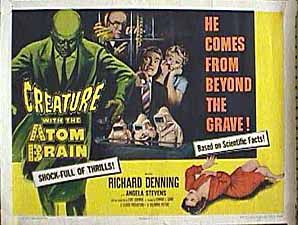
A gangster boss hires a mad-scientist Nazi living in a city with a poorly secured morgue, and whose office contains a neon Enron logo. Together they use remote-controlled, voice-activated radioactive zombies to eliminate all the people who sent the gangster to prison. The zombies kill by delivering a single, girly punch to their targets, making a sound like somebody dropping a single orange onto a carpeted floor. At at least one point, a non-zombie kills someone in the exact same way, suggesting that people are very soft and fragile here. Maybe the morgue the so insecure against body-thief Nazis because it gets so much traffic.
However, at one point a guy jumps out of a speeding car and suffers only uneven lapels, which he manages to straighten without help. Shrug.
The creepy middle-aged guy in this one doesn't seduce anyone, but he still manages to slime the audience by holding his friend's little daughter in a questionable fashion. Later he becomes an atomic zombie and stops touching her, but he does rip apart her dolly for no obvious reason, allowing us to draw whatever unfortunate conclusions about his tormented zombie psyche that we wish. The daughter actually gets the worst treatment in the film; her parents lie to her continually about the all the scary things happening around her (not just assuring her that it'll be all right, but actually making up false cover stories for her benefit), up to and including the very end of the film where they lie about her creepy Uncle Dave being a dead zombie and tell her that he'll visit again later. (Notably, the film seems to side with her at one point, where she reacts to being shooed from the room by observing that she never kicks any grown-ups out when talking with her friends.)
Evolution

As with "Happy Accidents", I avoided this film during its theater run last year, it enjoys the distinction of being exactly as bad as I expected. Adorable CG monsters attack a world populated solely by self-serving, hostile assholes, whether they are heroes, villains, or innocent bystanders. I can't stand movies that provide no likeable characters, even when the movies are quite intentionally silly. I can only think of this as entertainment for typical American type-A personalities who enjoy seeing people like them in movies, and can never bring myself to laugh. It didn't help that none of the genius scientist characters knew what the title word meant and yet used it to explain everything anyway.
Fortunately, I sat more or less alone in my cynicism. The crowd was vocal in its appreciation for this 3 a.m. showing, despite that fact that it had, a few hours earlier, booed the emcee's news that the marathon booked "Evolution" after it failed to successfully get a sneak preview of "The Time Machine".
The Terminal Man

Based on an early Michael Crichton novel that might have actually been interesting; you can sort of tell which points in the movie touch the curve of the original book, but most of the film seems graphically tangential. The story involves a genius mathematician who seeks to have his violent seizures cured by submitting to an operation that implants a computer in his brain. (As he's being wheeled to his hospital room he comments on a dumb terminal he sees in an office, thus providing ironic foreshadowing and an explanation of the movie's title.) Things Go Terribly Wrong when the computer, which stimulates neural electrodes to calm him down when he has an attack, gets stuck in a loop with with his biochemistry, causing him to have increasingly frequent attacks until he totally flips out beyond the level of electronic compensation and flies into a murderous rampage for a few minutes. And then the flip-outs start getting more frequent, too. So that's no fun.
I'm sure you could present this tragedy in all kinds of interesting ways, and this movie does none of them. After Basil Exposition tells gives us the scoop on the guy's plight, we get to watch the entire implantation surgery -- in real time. For what it's worth, it's a very well-executed neurosurgery scene. Obviously, the filmmakers were quite proud of it. Perhaps it existed in social context I don't know about, capitalizing on high public interest in brain surgery in the mid-70s. However, when the camera shows us a digital timer on the OR wall showing an elapsed time of 28 minutes, I got some laughs by saying "Yep, that seems about right." The audience cheered when the head surgeon announced a successful procedure, and then booed when he added that he needed 10 more minutes to sew up the patient's head.
This pales to the audience reaction once we discover that all the hospital scenes were simply a set-up for an hour-long slasher movie, as the broken mathematician stumbles around town in a blond shag wig and an immaculate white linen suit that's probably symbolic in some way while he stabs people with pinking shears. The audience quickly starts begging for a quick death for all the central characters, chanting "Jump! Jump!" every time someone approaches a window or balcony.
This leads to what will surely be one of the most beautiful moments of audience-bonding I shall ever experience. The guy, who now has a pistol, finds his way into a mortuary. A maintenance guy gets cheers for running away from him, thus becoming the first and only sensible character in the movie. The crowd gets increasingly wired as the mathematician wanders throgh a cemetary, knowing that things must surely come to head soon. And lo, the collective hopes of the viewers start to manifest on the screen, as if by uncanny supernatural force. He finds: an open grave! Yay! And then he jumps into it! Yay! And then the helicopter from "Iceman", seeing a chance to redeem itself, suddenly appears and someone in it shoots him! YAY! And then they shoot him again, just to make sure! PIII-TAAA!! It swear to you that it wouldn't have been weird if the camera pulled back to show Patrick Stewart in a wheelchair shaking his head sadly over the grave, or a sudden zoom-in to reveal a grinning Chuck Heston in the chopper.
After this movie, the emcee read through the list of titles, collecting an audience cheer/boo summary for each. After the floor-dropping tumult of negativity that was the "Terminal Man" score, he noted that people have been requesting that film for years, and now that they finally showed it, everyone hated it. Yet, I really do think it made for a wonderful finale.
All content on this page is copyright © 2002 by Jason McIntosh.
Return to jmac.org
 jmac@jmac.org
jmac@jmac.org jmac@masto.nyc
jmac@masto.nyc